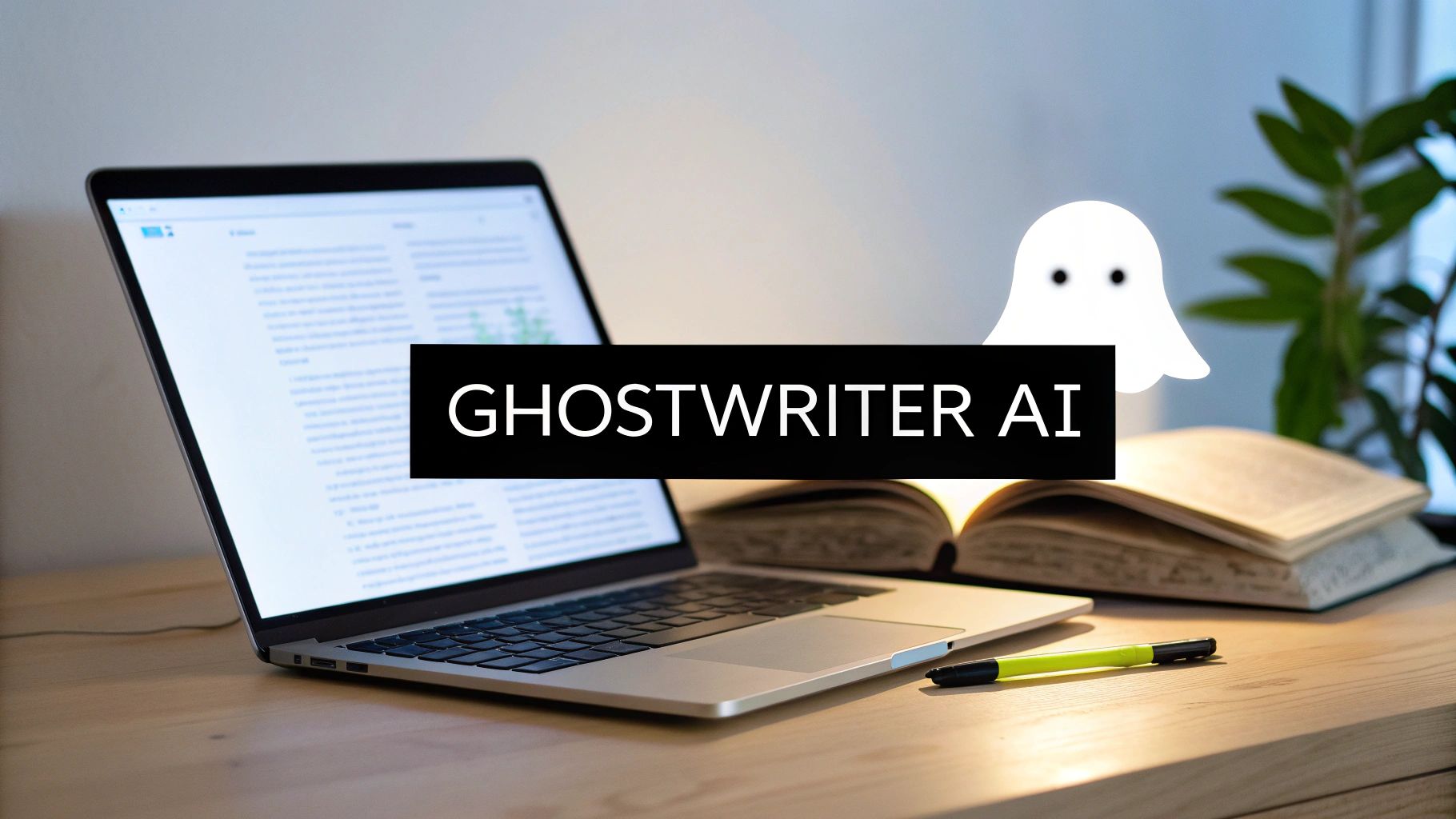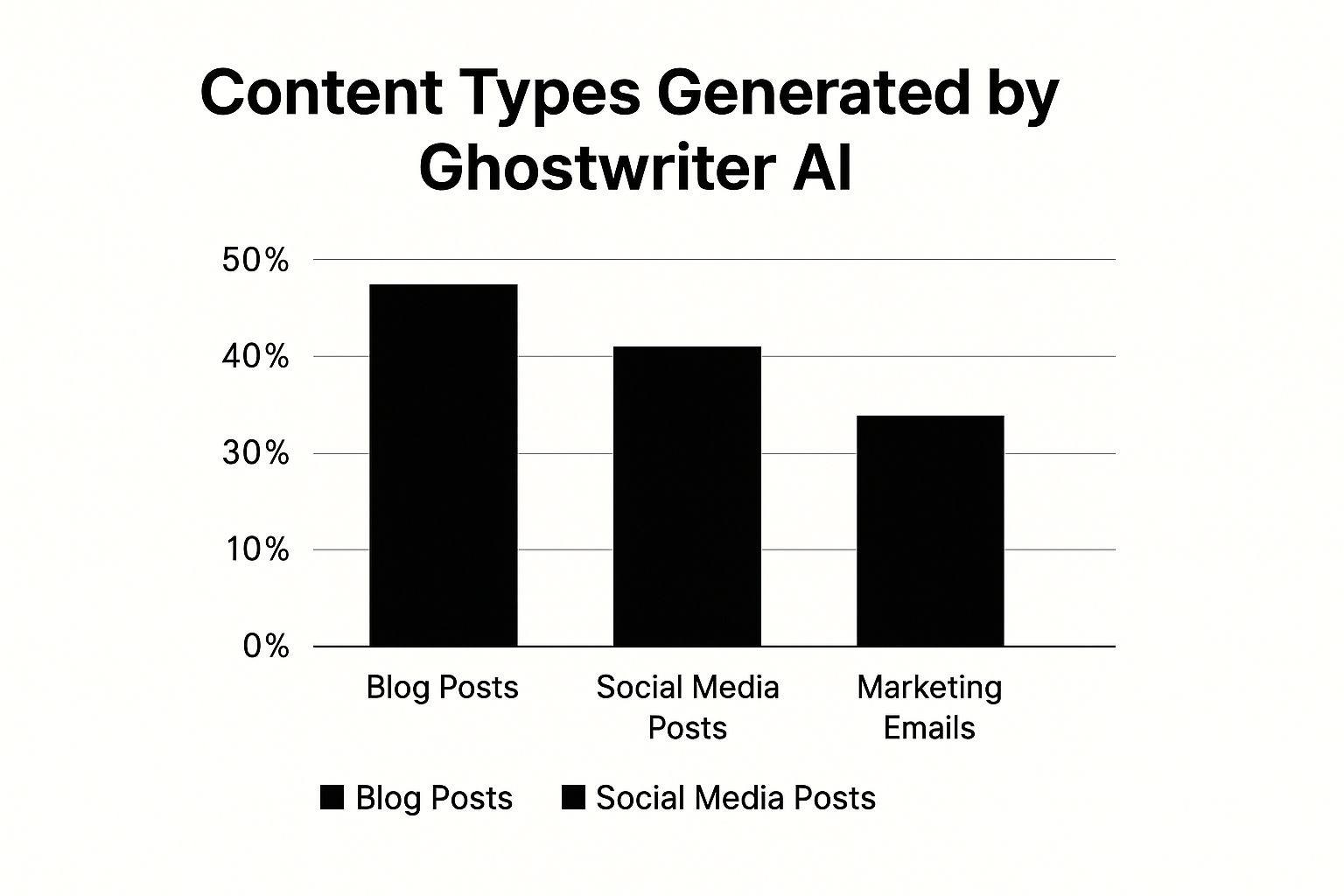
Discover How Ghostwriter AI Transforms Content Creation
Published on 2025-05-11
The Evolution of Ghostwriter AI: From Basic Text to Brilliance
Remember the early, somewhat clunky AI writing tools that produced robotic-sounding text? Things have changed significantly. Those basic text generators have evolved into sophisticated ghostwriter AI, capable of mimicking nuanced writing styles and understanding complex topics. This evolution is largely thanks to advancements in Natural Language Processing (NLP), the field of AI that focuses on enabling computers to understand and generate human language. This means AI can now move beyond simply arranging words and can actually grasp context and meaning.
For example, early AI struggled with things like the difference between "their," "there," and "they're," or understanding the meaning of idioms. Modern ghostwriter AI can recognize these nuances, creating more natural-sounding and engaging content. Furthermore, improvements in machine learning algorithms allow these tools to learn from massive datasets of text and code, constantly refining their ability to produce high-quality, human-like writing. This continuous learning process allows the AI to adapt to various writing styles and create content tailored to specific requirements.
The Expanding Role of AI in Content Creation
The growing sophistication of ghostwriter AI is reshaping content creation across diverse industries. This technology is no longer confined to simple tasks like generating short social media posts. Instead, it's being utilized for more complex projects, such as writing articles, blog posts, and even creative fiction. This expanding capability is causing us to rethink authorship and the very role of AI in the creative process.
This shift isn't happening in isolation. The broader AI market is experiencing rapid growth. By 2025, the global AI market was valued at over $600 billion, with much of this growth driven by advancements in AI tools and technologies. Explore this topic further. The AI market is also projected to increase in value by over five times in the coming years, pointing towards even greater integration of AI into fields like ghostwriting. This growth is expected to lead to more efficient and cost-effective content creation solutions.
From Assistant to Collaborator
The evolution of ghostwriter AI represents a shift from AI as a mere assistant to AI as a genuine collaborator. Initially, AI writing tools were mainly used for basic tasks like grammar checks and generating short snippets of text. Today's ghostwriter AI, however, can handle much more, including:
- Generating outlines and first drafts
- Conducting research and compiling information
- Adapting to different writing styles and tones
- Creating various content formats, from blog posts to scripts
This expanded functionality allows content creators to focus on higher-level tasks, such as strategy and creative direction, while the AI handles the more tedious parts of writing. This human-AI collaboration has the potential to significantly boost productivity and enhance content quality. As ghostwriter AI continues to evolve, we can anticipate even greater capabilities and a further blurring of the lines between human-written and machine-generated content.
How Ghostwriter AI Is Transforming Real-World Content Creation
How are professionals using ghostwriter AI in their daily work? These tools are helping content teams overcome creative blocks, produce more content, and maintain consistent quality. The goal isn't to replace human creativity, but to enhance it.
Many marketing teams use ghostwriter AI for research and initial drafts. This allows human writers to focus on higher-value tasks like creative direction, strategy, and adding the nuances that AI still lacks. This division of labor leads to efficient workflows and better resource allocation.
Streamlining Workflows with AI Assistance
A key benefit of ghostwriter AI is its ability to streamline content creation. It's like having a dedicated research assistant who quickly gathers and organizes information. This is especially helpful for busy content teams that need to produce a lot of content regularly.
Ghostwriter AI also helps maintain a consistent brand voice across platforms and content formats. This is vital for building a strong brand identity and aligning messaging with marketing goals. Whether it's social media posts, blog articles, or email newsletters, ghostwriter AI can ensure stylistic consistency. Check out our guide on How to master social media content planning.
Real-World Results and Impact on Content Strategy
Integrating ghostwriter AI is producing tangible results. Some teams report creating 3x more content while also improving audience engagement. This increased efficiency demonstrates the power of combining human creativity with AI assistance.
It's important to understand the changing role of AI in content creation. AI writing software and machine learning, like ChatGPT, are transforming the industry, indirectly affecting even traditional ghostwriting. ChatGPT can generate 25,000 words and understand over 26 languages, demonstrating AI’s potential. As of March 2025, it had 400 million weekly active users.

While AI won’t completely replace human ghostwriters, it's increasingly used to augment the writing process, potentially lowering costs and boosting efficiency. Find more detailed statistics here. This trend will likely continue as AI technology advances. Content creators who adapt and learn to use AI tools effectively will be best positioned for future success. Mastering these tools is becoming a crucial skill for content creators.
Inside the Toolbox: Leading Ghostwriter AI Platforms Compared
Choosing the right AI ghostwriting tool can feel like navigating a maze. Marketing hype often obscures the true strengths and weaknesses of each platform. This section cuts through the noise, offering a clear comparison of leading ghostwriter AI platforms based on extensive testing and user feedback. Understanding the differences in output quality, customization, and learning curve is essential for achieving your content goals.
Key Features and Capabilities
Different ghostwriter AI platforms excel in different areas. Some are ideal for crafting short-form content like social media posts, while others are better suited to long-form articles or creative writing. Let's explore some key features:
Content Generation: Most platforms offer a range of content formats, including blog posts, articles, emails, and social media updates. However, the quality and originality of the generated content can vary significantly.
Customization: Some platforms offer extensive customization options, allowing you to fine-tune the tone, style, and length of the generated content. Other platforms provide less flexibility.
Ease of Use: Some tools have user-friendly interfaces that are easy to grasp, even for beginners. Others require more technical know-how.
Integration: Some platforms integrate seamlessly with other tools and services, such as content management systems (CMS) or SEO tools.
To help you choose the best platform for your needs, let's take a closer look at what the top contenders offer. The following table summarizes key information about each platform.
Comparison of Leading Ghostwriter AI Platforms This table compares the top ghostwriter AI platforms based on key features, pricing, content quality, and specialized capabilities.
| Platform | Best For | Key Features | Price Range | Content Quality | Learning Curve |
|---|---|---|---|---|---|
| Arvow | Automated content & SEO | AI writing, Google indexing, auto-publishing | Contact for pricing | High | Easy |
| Jasper AI | Human-like articles & essays | User-friendly, many templates | $29-$500/month | High | Medium |
| Copy.ai | Multilingual content | 90+ tools and templates | $36-$432/month | Medium | Easy |
| Hypotenuse AI | Product descriptions & articles | Content Detective, chat features | $29-$299/month | Medium | Medium |
| Sudowrite | Fiction & creative writing | Multiple language models, idea generation | $10-$100/month | Medium | Medium |
As you can see, each platform offers a unique set of features and capabilities. Choosing the right one depends on your specific content needs and budget.
Content Type Distribution
The following infographic illustrates the typical distribution of content types generated by ghostwriter AI across various platforms.

As the infographic reveals, blog posts make up the largest segment (45%) of content generated by ghostwriter AI. This is followed by social media posts (30%) and marketing emails (25%). This distribution reflects the high demand for quality, SEO-friendly blog content and the growing use of AI for social media management. It's worth noting that these percentages can vary based on the specific platform and individual user requirements.
Combining AI Tools for Optimal Results
Many content teams achieve optimal results by strategically combining different AI tools. Some teams, for instance, might use one platform for generating initial drafts and another for editing and polishing the content. This approach allows them to leverage the strengths of each tool while minimizing their individual weaknesses. This flexibility to mix and match tools is key for tailoring AI assistance to specific content needs. Understanding the ideal use cases for each platform allows you to create a robust and adaptable content creation workflow.
The Booming Business of Ghostwriter AI Services

The rise of ghostwriter AI is changing how we think about content creation. It's not just a technological shift; it's opening up new doors for entrepreneurs and content creators while challenging established writing services to adapt. This exciting blend of human creativity and AI assistance is creating a vibrant and fast-moving market.
Market Growth and Emerging Opportunities
The need for high-quality content keeps growing across many industries, pushing the ghostwriting services market forward. This growth creates interesting prospects for AI-driven tools.
Specifically, sectors like marketing and technology, always hungry for fresh content, are quickly adopting ghostwriter AI tools like Jasper or Copy.ai. This adoption boosts innovation and expands the possibilities of AI-generated content.
To understand the market's scope, let's look at some key statistics. The following table outlines the current and projected value of the ghostwriter AI market, its growth rate, and leading regions.
The data highlights the significant expansion expected in the ghostwriter AI market.
Ghostwriter AI Market Statistics
| Metric | 2023 Value | 2025 Value | Growth Rate | Leading Region |
|---|---|---|---|---|
| Global Ghostwriting Services Market | $2.45 billion | |||
| North America Market Share | 28.50% | North America | ||
| Projected CAGR (2023-2030) | 6.80% | |||
| North American Ghostwriting Services | $542.555 million (2021) | $698.336 million | North America |
These figures, from Cognitive Market Research, show significant growth in the North American ghostwriting market. While AI's influence isn't dominant yet, its potential is clear, especially with the increasing popularity of AI writing software.
Hybrid Human-AI Workflows: The Path Forward
Smart agencies are adopting hybrid human-AI workflows, realizing AI is a tool to empower writers, not replace them. This understanding leads to workflows that leverage both human and AI strengths.
AI excels at research, initial drafting, and creating content variations. Resources like this guide on content repurposing strategies show how valuable these AI tools can be. This allows human writers to focus on strategy, creative direction, and adding the nuanced elements that connect with an audience. This teamwork often results in better content, produced faster and more efficiently.
Adapting to the Technological Shift
The integration of AI into ghostwriting presents challenges and opportunities. Traditional writing services must adapt, either by integrating AI or highlighting the uniquely human elements of writing that AI can't reproduce. This creates a dynamic and competitive industry.
This shift also creates opportunities for entrepreneurs and content professionals. Those who embrace and learn these new tools will be well-placed for success. Leveraging AI is becoming a crucial skill for anyone working with content. This evolving environment rewards adaptability and a willingness to explore AI's potential.
When to Embrace (and When to Avoid) Ghostwriter AI
Ghostwriter AI presents exciting possibilities for content creation, but it isn't a universal solution. Understanding its strengths and weaknesses is key to maximizing its effectiveness. This means knowing which tasks are well-suited for AI assistance and which require a human touch. This strategic approach ensures you're using ghostwriter AI wisely.
Ideal Use Cases for Ghostwriter AI
Ghostwriter AI shines in tasks that benefit from automation and large-scale production:
First Drafts: AI can rapidly generate initial drafts, helping overcome writer's block and saving valuable time. This allows human writers to focus on refining and polishing the content.
Content Repurposing: Transforming existing content into different formats (like turning blog posts into social media snippets) is a task AI handles with efficiency.
Generating Variations: Need several versions of ad copy or social media posts? Ghostwriter AI can quickly create numerous options.
Research and Information Gathering: AI can efficiently compile information on a specific topic, creating a solid base for content creation.
SEO Optimization: Some ghostwriter AI tools, such as Arvow, can optimize content for search engines, improving visibility and reach.
These examples demonstrate how ghostwriter AI can boost productivity and streamline your content creation process.
When Human Expertise Is Essential
While powerful, ghostwriter AI still requires human intervention for specific content tasks:
Complex or Sensitive Topics: AI can struggle with nuanced arguments or emotionally charged subjects. Human writers are better equipped to navigate these complexities.
Content Requiring Original Thought and Analysis: AI excels at summarizing and rephrasing, but it falls short in generating truly original insights or in-depth analysis.
Building Emotional Connections: Content that resonates emotionally with readers typically requires human creativity and empathy, something AI currently lacks.
Brand Voice and Style: AI can mimic various writing styles, but maintaining a consistent and authentic brand voice often needs human oversight.
Fact-Checking and Accuracy: AI-generated content should always be fact-checked by a human to guarantee accuracy and avoid misinformation. As demonstrated in the Factory Network hackathon project, AI can sometimes fabricate facts.

Recognizing these limitations ensures you are using ghostwriter AI strategically, avoiding reliance on it for tasks beyond its current capabilities.
The Power of Hybrid Workflows
The most effective approach frequently involves a hybrid workflow, combining the strengths of both AI and human writers. This collaborative approach lets AI handle tasks like initial drafting and research, while human writers concentrate on refining, adding depth, and ensuring accuracy.
For example, a marketing team could use ghostwriter AI to generate initial blog post drafts. Human writers would then edit these drafts, adding their unique perspectives, guaranteeing accuracy, and refining the brand voice. This collaborative approach produces high-quality content efficiently. Content creation becomes a joint effort, using the speed and efficiency of AI while preserving the essential human element.
This strategy lets you maximize the benefits of ghostwriter AI while ensuring your content stays engaging, accurate, and aligned with your objectives. By embracing this hybrid approach, you can achieve new levels of productivity and content quality.
What's Next: The Future of Ghostwriter AI and Human Creativity
The field of ghostwriter AI is evolving at a rapid pace, constantly expanding the possibilities of content creation. This begs the question: what does this mean for content creators, strategists, and business leaders? By examining emerging trends and predictions, we can gain a better understanding of the dynamic relationship between human creativity and AI assistance.
Emerging Capabilities and Advancements
Next-generation ghostwriter AI systems are being developed with sophisticated capabilities. These improvements target key areas that will fundamentally change how we create content.
Emotional Intelligence: Future AI tools may be able to understand and incorporate subtle emotional nuances into the content they generate, leading to more compelling and relatable stories.
Specialized Domain Expertise: We can anticipate the emergence of AI tools trained on specific industry knowledge. This specialized training will allow them to create highly accurate and relevant content within a particular field.
Contextual Awareness: Future AI is likely to become even more adept at understanding context. This enhanced understanding will result in more relevant and insightful content that truly resonates with the target audience.
These advancements will further blur the distinction between human-written and AI-generated content. This naturally leads to important questions about authorship, originality, and the future of creative expression in the digital age.
Adapting to the Changing Landscape
Forward-thinking organizations are already preparing for these shifts by exploring human-AI hybrid workflows. These workflows combine the strengths of both humans and AI. You might be interested in: How to master your LinkedIn thought leadership strategy. By combining AI's efficiency with human creativity and insight, organizations can aim for maximum content quality and productivity.
However, the increasing use of ghostwriter AI also brings potential regulatory challenges. As this technology proliferates, important questions will need to be addressed regarding copyright, plagiarism, and the ethical implications of AI-generated content.
Positioning Yourself for the Future
As the content creation landscape evolves, it's essential for content creators, strategists, and business leaders to adapt. Here are some key strategies for navigating this changing environment:
Embrace Lifelong Learning: Continuously updating your skills and knowledge is vital for staying ahead of the curve in this rapidly changing field.
Experiment with AI Tools: Don't hesitate to explore different ghostwriter AI platforms and find ways to integrate them effectively into your workflows.
Focus on Your Unique Human Skills: Emphasize the skills that are still difficult for AI to replicate, such as creativity, critical thinking, and emotional intelligence.
Develop a Hybrid Skillset: Learn to work collaboratively with AI, leveraging its strengths while simultaneously honing your own unique abilities.
By actively preparing for and adapting to these changes, content creation professionals can position themselves for success in the age of ghostwriter AI. The future of content creation is collaborative, blending human ingenuity with the power of artificial intelligence.
Ready to enhance your LinkedIn content creation? autoghostwriter utilizes advanced AI technology to help you craft engaging and impactful posts. Explore the different subscription plans available, designed for everyone from individuals to power users at autoghostwriter.com. Whether you're just starting out or looking to scale your content efforts, autoghostwriter provides the tools and inspiration to elevate your LinkedIn presence.